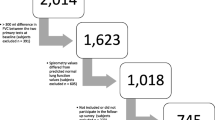Summary
-
1.
Sixty young male subjects were exercised on a bicycle ergometer at a constant load of 140 Watts (840 Kgm/min) thrice daily for 5 days.
-
2.
The relationship between an assessment of the exercise taken by each subject (‘fitness’ grading) and 26 measurements of pulse rate, ventilation, personality, and other variables was investigated by a series of multiple regression analyses.
-
3.
The optimum regression equation incorporated three negative coefficients (the pulse rate 15 min after exercise on Day 1, the change in end-exercise pulse rate from Day 1 to Day 4, and the extraventilation of exercise on Day 1) and three positive coefficients (‘resting’ ventilation, extraventilation during the first minute of exercise, and the change in pulse rate 15 min after exercise from Day 1 to Day 4).
-
4.
The optimum equation accounted for 58% of the variance of the ‘fitness’ grading. A prediction of maximal oxygen consumption by the Astrand nomogram accounted for only 35%.
-
5.
Certain practical objections to the Åstrandnomogram are pointed out.
-
6.
The physiological significance of the regression coefficients is discussed.
Similar content being viewed by others
References
Åstrand, I: Aerobic work capacity in men and women with special reference to age. Acta physiol. scand.49, Supp.169, 1956.
Åstrand, P. O.: Physical fitness in relation to age and sex. In: International Research in Sport and Physical Exercise, Ed.E. Jokl, andE. Simon. Springfield (Ill.): Thomas 1964.
Borg, G., andH. Dahlström: The reliability and validity of a physical work test. Acta physiol. scand.55, 353–361 (1962).
Cureton, T. K., andL. F. Sterling: Factor analyses of cardio-vascular test variables. J. Sport Med. Phys. Fitness4, 1–24 (1964).
Dejours, P.: Control of respiration in muscular exercise. Handbook of Physiology, Respiration I (Ed.W. O. Fenn, andH. Rahn). American Physiological Society, Washington, D. C. 1964.
Eysenck, H. J.: Manual of the Maudsley Personality Inventory. University of London Press, Ltd. 1959.
Henry, F. M., andW. E. Berg: Physiological and performance changes in athletic conditioning. J. appl. Physiol.3, 103–111 (1951).
Karpovich, P.: Physiology of muscular activity. Philadelphia: Saunders 1959.
Kendall, M. G.: A course in multivariate analysis. London: Griffin Co., Ltd. 1957.
Krestovnikov, A. N.: Physiologie der Körperübungen. Quoted by F. J. A.Kreuzer in: International Research in Sport and Physical Education. Springfield (Ill.): Thomas 1953.
Larson, L. A.: A factor analysis of some cardio-vascular tests with tests for college men. Res. Quart. Amer. Ass. Hlth phys. Educ.12, 499–517 (1941).
Lawley, D. N., andA. E. Maxwell: Factor analysis as a statistical method. London: Butterworths 1963.
Margaria, R.: An historical review of the physiology of oxygen debt and steady state in relation to lactic acid formation and removal. In: International Research in Sport and Physical Exercise, Ed.E. Jokl, andE. Simon. Springfield (Ill.): Thomas 1964.
McCloy, C. H.: A cardiovascular rating of present condition. Arbeitsphysiologie4, 97–108 (1931).
- A study of cardiovascular variables by the method of factor analysis. Proc. Soc. Res. Child Dev. 107–111 (1936).
Murphy, M. A.: A study of the primary components of cardiovascular tests. Res. Quart. Amer. Ass. Hlth phys. Educ.11, 57–71 (1940).
Pelzer, A.: Studies on the airflow conductance in the human respiratory tract. Ph. D. Thesis, University of London 1965.
Rowell, L. B., H. L. Taylor, andY. Wang: Limitations to prediction of maximal oxygen intake. J. appl. Physiol.19, 919–927 (1964).
Shephard, R. J.: Physiological determinants of cardio-respiratory fitness. Canad. med. Serv. J. (In press) (1965 a).
- Principal component analysis of the responses to standard exercise training. Ergonomics. (In press) (1965 b).
- Initial fitness and personality as determinants of the response to a training regime. Ergonomics. (In press) (1965 c).
Author information
Authors and Affiliations
Rights and permissions
About this article
Cite this article
Shephard, R.J., McClure, R.L. The prediction of cardio-respiratory fitness. Int. Z. Angew. Physiol. Einschl. Arbeitsphysiol. 21, 212–223 (1965). https://doi.org/10.1007/BF00694937
Received:
Issue Date:
DOI: https://doi.org/10.1007/BF00694937




